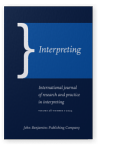Vol. 26:1 (2024) ► pp.80–113
Coordination in telephone-based remote interpreting
Telephone-based remote interpreting has come into widespread use in multilingual encounters, all the more so in times of refugee crises and the large influx of asylum-seekers into Europe. Nevertheless, the linguistic practices in this mode of communication have not yet been examined comprehensively. This article therefore investigates selected aspects of turn-taking and clarification sequences during semi-authentic telephone-interpreted counselling sessions for refugees (Arabic–German). A quantitative analysis reveals that limited audibility makes it more difficult for interpreters to claim their turn successfully; in most cases, however, turn-taking occurs smoothly. The trouble sources that trigger queries are mainly content-related and interpreters vary greatly in the ways they deal with such difficulties. Contrary to what one might expect, the study shows that coordination fails only rarely during telephone-based remote interpreting.
Article outline
- 1.Introduction
- 2.Previous research on telephone-based interpreting in bilateral community settings
- 3.The TIGA Corpus: Data collection and transcription
- 3.1Data collection
- 3.2Data transcription
- 4.Categories of analysis
- 4.1Turn-taking
- 4.1.1Types of turn acquisition: Smooth vs forced turn-taking
- Smooth turn-taking
- Forced turn-taking
- 4.1.2Failed turn-taking (turn claims)
- Claiming the turn at a transition relevance place
- Claiming the turn at a non-transition relevance place
- 4.1.1Types of turn acquisition: Smooth vs forced turn-taking
- 4.2Trouble sources
- 4.2.1Acoustic perception
- 4.2.2Lack of visual cues, lack of transparency: Irritated interlocutors
- 4.2.3Dialect
- 4.2.4Content
- 4.2.5“Cognitive load”
- 4.2.6Mix of trouble sources
- 4.1Turn-taking
- 5.Quantitative analysis
- 5.1Turn-taking
- 5.1.1Interpreters’ successes and failures at taking over: Turn acquisitions vs turn claims
- 5.1.2Limited audibility as a challenge to turn-taking
- 5.2Trouble sources
- 5.1Turn-taking
- 6.Conclusions
- Acknowledgements
- Notes
-
References
For any use beyond this license, please contact the publisher at [email protected].
